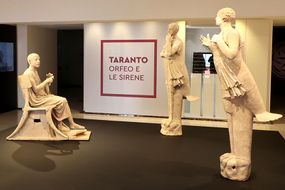From 19 February to 30 June 2024
The exhibition presents the extraordinary discoveries made in 2022 in the Etruscan and Roman thermal sanctuary of Bagno Grande in San Casciano dei Bagni. The exhibition, curated by the Director General of Museums, Massimo Osanna and Jacopo Tabolli, professor of the University for Foreigners of Siena, unfolds like a journey through the centuries within the landscape of the warm waters of the territory of the ancient city- Etruscan state of Chiusi.
Part of the Etruscan and Roman sanctuary emerged near the Bagno Grande, built around a basin built in travertine blocks, over four meters deep. The basin already existed in the Etruscan age and was then renovated and enlarged during the reign of the emperor Tiberius (1st century AD) and welcomed votive offerings until the 4th century AD. The oldest offerings with statues date back to the 3rd century BC and for throughout the 2nd and 1st centuries BC. They were found deposited together in the first decades of the 1st century AD, over three meters deep and under a compact layer of tiles. The only finds that come from the layer of tiles are a bronze lightning bolt and a flint arrow which could represent a fulgur conditum (the ritual of the buried lightning bolt). According to the principle of ars fulguratoria (the art of interpreting lightning), of Etruscan tradition, what was struck by lightning inside a temple or sanctuary had to be buried on the same site of the miracle and the lightning itself it had to be “buried”. The burial site – in this case the tub itself – was called bidental.
Over twenty statues and figurines, thousands of bronze coins and anatomical votive offerings tell a story of devotion, cults and rites hosted in sacred places where the thermal water was also used for therapeutic purposes. The exceptional state of conservation of the statues inside the hot water has also allowed the handing down of long inscriptions in Etruscan and Latin which tell of the people who frequented the sacred place, of the deities invoked and of the co-presence of Etruscans and Romans around the water hot. The exhibition, at MANN for its second stage after the exhibition at the Scuderie del Quirinale, is enriched with four 'new' fundamental pieces. The bronze statue of a female figure with her hands open for prayer and wearing a chiton and a cloak, found among the offerings inside the sacred basin, in a group of statues that embraced a large oak trunk. The second is the base of a travertine donary, which exceptionally features a 'bilingual' inscription. The right half of the inscription is written in Etruscan, from right to left, while the left half is in Latin, reading from left to right. This is an exceptional document of the public use of Etruscan still at the beginning of the Augustan age.
The expression of the entity of the divinity, which is speaking in the two languages, summarizes the existence of different recipients in multiple communities welcomed by the sanctuary, with the need to be understood by all. From the 2023 excavation campaign to the Bagno sanctuary Large numbers of new bronzes come from, attributable to the religious and ritual practices of this spa spa. Among these, although small in size, an artefact stands out which can be included in the group of anatomical ex-votos. It is probably a miniature version of the kidney. Finally, carved in a precious fragment of white and perfectly transparent rock crystal, with rare and imperceptible impurities, a pendant in the shape of a little fish. In ancient times, rock crystal was considered to have numerous beneficial and medical properties, as well as being used as a burning lens to treat wounds, and being believed to be petrified ice, it was considered useful for preserving the sleep of the deceased and delaying the decay of the body. It dates back to the first decades of the 1st century. BC and was found near the cold water source outside the temple, inside a hearth, in connection with an iron knife blade. Evidently part of a ritual action that took place before the transformations of the temple following the fall of lightning in the Tiberian age.

Piazza Museo n.18/19, Naples, Italy
Opening hours
| opens - closes | last entry | |
| monday | 09:00 - 19:30 | |
| tuesday | Closed now | |
| wednesday | 09:00 - 19:30 | |
| thursday | 09:00 - 19:30 | |
| friday | 09:00 - 19:30 | |
| saturday | 09:00 - 19:30 | |
| sunday | 09:00 - 19:30 |

From 1 March to 31 December 2025
Orpheus and the Sirens

MArTA - National Archaeological Museum of Taranto, Taranto